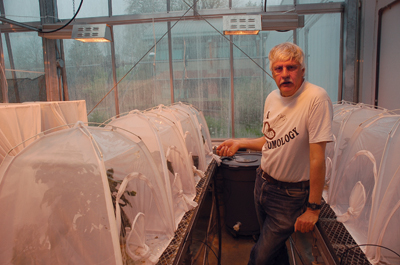
The bug hunter is continuing his hunt for bugs who hunt bugs.

|
|
| Dr. David Gillespie with some of the parasitoid cages.
|
The bug hunter is continuing his hunt for bugs who hunt bugs.
Entomologist David Gillespie of the Pacific Agriculture Research Centre
in Agassiz, British Columbia, has spent the past three years looking
for and evaluating new parasitoids to attack green peach aphids and
foxglove aphids. He updated greenhouse growers on his findings during a
research day at PARC.
“There is a lot of stuff which looks interesting,” he said. After
collecting and initially analyzing over a dozen different parasitoids,
he has focused his attention on praon gallicum and praon humulaphidis,
aphidus ervi and aphelinus asychis.
While the brown lacewing Micromerus variegatus also looks extremely
promising, he has not worked on it. Instead, that research is being
done by Applied Bionomics, British Columbia’s primary supplier of
biocontrols for the greenhouse industry.
To test the effectiveness of each parasitoid, a number of them are
placed in a cage with one or more plants and a select number of aphids.
“We then watch what happens,” Gillespie stated.
DETERMINING OPTIMAL RATIO OF PARASITOIDS TO APHIDS
The number of aphids and parasitoids are regularly counted so he can
determine which parasitoids perform best, and what would be the optimum
ratio of parasitoids to aphids.
Recent trials showed similar results from all four parasitoids at a
ratio of one adult parasitoid to five aphids. While the number of
aphids in a control cage (with no parasitoids) reached 1,400 within
three weeks, all four parasitoids managed to keep aphid numbers to less
than 200 over the same period. The best result came from the praon
humulaphidis, which kept its aphid population down to 100. “It performs
best over the long term,” Gillespie said.
When confronted by parasitoids, the aphids’ survival instincts kick in.
They become very active and attempt to run away from the predators or
jump off the plant leaves to escape. Given that behaviour, Gillespie
has tried adding sticky tape to capture the aphids dropping off the
plants. The attempt appears to have worked.
POSSIBLE COMMERCIALIZATION OF PRAON HUMULAPHIDIS
“Aphid numbers plummeted by the end of the first week,” he said, but
noted there were lots of variation between cages and the number of
parasitoids also dropped dramatically.
“We’re not at the stage of recommending sticky tape,” he told growers.
While it might help over the short term, the long-term impact is yet
unknown and Gillespie does not intend to pursue it.
He is, however, pursuing commercialization of praon humulaphidis as an
aphid predator. “Our next stage is to get an insectory involved.”
David Schmidt is a freelance writer and photographer in British Columbia.
Print this page